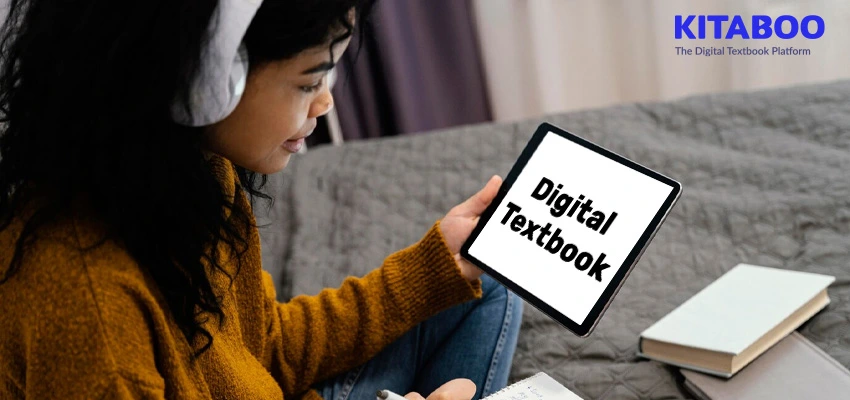
How to Create Engaging Digital Textbooks That Teachers Actually Want
Summarize this blog with your favorite AI:
Digital publishing generated revenue of $13.4 billion in 2022 and aims to reach a significant $29.5 billion by 2027, so the digital textbook industry has rapidly evolved.
However, engaging digital textbooks are not just about numbers. Many of these textbooks today lack interactivity, making them less effective for teachers and students. One of the important issues to explore here is the accessibility and engagement in digital textbooks that makes them useful for both learners and teachers.
In this blog, we will explore more about the nature of digital textbooks and outline the process of making them more engaging using AI-powered tools and simulations. We will also discuss how KITABOO, a leading digital textbook platform, allows you to easily create engaging digital textbooks by using various multimedia elements, AI-powered simulations, and more.
Table of Contents:
I. What are Engaging Digital Textbooks?
II. How Does Advanced Technology Enhance Digital Content Creation?
III. Best Practices for Incorporating Interactive Elements in Digital Textbooks
- Content for Virtual and Augmented Reality (VR/AR)
- Video and Animations
- Gamification
- Using Descriptive Alt-Text for Images
- Interactive Infographics and Maps
IV. Real-world Examples of Effective Digital Engagement
V. To Wrap Up
What are Engaging Digital Textbooks?
A digital textbook, also called an online textbook, is nothing but an upgraded version of traditionally printed textbooks. This technology allows students to read books on their smart devices, including laptops, tablets, or e-readers.
However, unlike traditional books, engaging digital textbooks can be packed with a range of engaging learning materials and other interesting resources, such as videos, quizzes, and animations embedded in the text.
You can carry these digital textbooks in a single device and you also get the advantage of the latest info as they’re easy to update. This means that learners have access to traditional textbook information. Still, the same can be conveniently merged with the dynamic capabilities of digital technology to create a more interactive learning experience.
How Does Advanced Technology Enhance Digital Content Creation?
Artificial intelligence (AI) plays an important role in making digital textbooks immersive by customizing the learning path for every learner. There are several AI-powered tools, simulations, and multimedia available that you can use to analyze individual learning patterns, positives, and negatives, to be able to deliver customized content and activities.
For instance, using an AI-powered app allows you to identify a learner’s struggle with a specific area and, accordingly, offer targeted practice questions and visual aids to reinforce their understanding of the same.
In addition to this, AI can also simulate real-world scenarios, offering students instant feedback and guiding them through difficult concepts. These AI-powered tools and other multimedia elements help make learning much more immersive and effective by facilitating streamlined digital content creation.
Best Practices for Incorporating Interactive Elements in Digital Textbooks
One of the most essential components of engaging digital textbooks is interaction. If various interactive elements and teacher resources, such as interactive games, simulations, quizzes, and activities, are incorporated into these textbooks, learners and teachers are actively involved in the learning process.
Here are some of the ways and best practices to incorporate these interactive elements and enhance universal accessibility in digital textbooks:
1. Content for Virtual and Augmented Reality (VR/AR)
By mimicking real-world settings or projecting digital content onto the actual world, VR and AR technologies offer both immersive and engaging learning experiences to students. Leveraging these technologies allows students to carry out different experiments and participate in several practical learning activities.
2. Videos and Animations
3. Gamification
Various gamification elements, such as leaderboards, reward points, etc, serve as excellent tools to boost learner motivation. Gamification in digital textbooks allows students to earn rewards, points, or stars by completing checklist items successfully, thus unlocking extra content with high performance. By making your digital textbooks more game-like, you can make learning more fun, all while supporting a student’s specific learning objectives.
4. Use Descriptive Alt Text for Images
It is important to make sure that all your images, graphs, and charts in digital textbooks have descriptive alt text so that screen readers can easily convey this information to visually impaired users.
5. Interactive Infographics
Adding infographics and maps into digital textbooks supports higher interactivity and gives readers an easy-to-interpret overview, thus breaking down content and information into more digestible and memorable parts.
Real-world Examples of Effective Digital Engagement
Some of the top examples of effective digital textbook engagement features include interactive simulations, 3D models, clickable links to further information, embedded videos, drag-and-drop activities, highlighted key terms, personalized learning paths, and augmented reality experiences.
Apart from engaging learners, interactivity in digital textbooks is designed to actively involve students with the learning material beyond just reading text.
Here are a few real-life examples of student engagement across different subjects:
- Science: A digital science textbook could include an interactive simulation where learners can manipulate a model of a cell to explore its organs and functions.
- Math: A digital math textbook might have interactive graphs and maps where students can adjust different variables to see the changes in the equation visually.
To Wrap Up
To make engaging digital textbooks that attract both learners’ and teachers’ attention requires a great deal of time, resources, and attention to detail. In this post, we have discussed how you can make your digital textbooks more engaging for both learners and teachers.
To make this process even simpler and more productive, it is best to leverage the various tools available on the KITABOO platform. This will not only streamline the process of creating digital textbooks but also help ensure learners’ engagement and enhance their overall learning experience.
To know more about digital textbook creation and publishing for higher student engagement, contact us today.
Also Check:
Discover how a mobile-first training platform can help your organization.
KITABOO is a cloud-based platform to create, deliver & track mobile-first interactive training content.


![Top 5 Free Publishing Sites for Independent Publishing [2026]](https://kitaboo.com/wp-content/uploads/2025/09/Top-5-Free-Publishing-Sites-for-Independent-Publishing-2026-420x235.webp)
